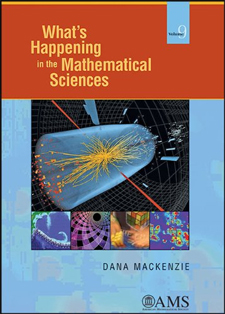
What's Happening in the Mathematical Sciences, Volume 9 by Dana Mackenzie.
 |
Available in softcover from the AMS Bookstore
|
About the Author
 Dana Mackenzie is a freelance writer who specializes in mathematics and science. His love of both mathematics and writing began at a young age. When he was growing up, he was a big fan of Martin Gardner’s “Mathematical Games” columns in Scientific American. A smaller but also important influence was George Pólya’s two-book series Induction and Plausible Reasoning, which Mackenzie received as a math prize in high school. He graduated from Swarthmore College in 1979 and earned his Ph.D. in mathematics from Princeton University in 1983.
Dana Mackenzie is a freelance writer who specializes in mathematics and science. His love of both mathematics and writing began at a young age. When he was growing up, he was a big fan of Martin Gardner’s “Mathematical Games” columns in Scientific American. A smaller but also important influence was George Pólya’s two-book series Induction and Plausible Reasoning, which Mackenzie received as a math prize in high school. He graduated from Swarthmore College in 1979 and earned his Ph.D. in mathematics from Princeton University in 1983.
For thirteen years Mackenzie taught at Duke University and at Kenyon College, and he was particularly pleased to receive an award named after one of his models — the George Pólya Award for expository writing from the Mathematical Association of America. Nevertheless, he was not satisfied with his academic career, in part because the writing opportunities were too limited. In 1996 he heard about the Science Communication Program at the University of California at Santa Cruz and decided to take a chance on a new career as a popular writer. After graduating and completing a short internship with American Scientist, Mackenzie returned to Santa Cruz and started working as a freelancer.
Since 1997, Mackenzie has written for such magazines as Scientific American, Science, New Scientist, Discover, and Smithsonian. His first trade book, The Big Splat, or How Our Moon Came to Be, appeared on Booklist’s best-of list for 2003 and was one of Audible.com’s audiobooks of the year for 2010. Princeton University Press published his first full-length popular book about mathematics, titled The Universe in Zero Words, in 2012. In addition, he wrote volumes 7 and 8, and half of volume 6, in the What’s Happening in the Mathematical Sciences series. He received the Communication Award from the Joint Policy Board for Mathematics in 2012.
Mackenzie still lives in Santa Cruz with his wife Kay, his cat Max, and an ever-changing array of foster kittens.
This page is maintained by the author.
Contact information:
Dana Mackenzie
1165 Whitewater Cove
Santa Cruz, CA 95062
![]()
About the book:
What's Happening in the Mathematical Sciences looks at some highlights of the most recent developments in mathematics. These include the mathematics behind stories that made headlines, as well as fascinating mathematical stories that never made it into the newspapers.
In 2009, a flu pandemic, the world's first in more than 40 years, tested a new generation of mathematical models that take some of the guesswork out of public health decisions. As health officials rushed to quell the outbreak of H1N1 flu, mathematicians were working just as hurriedly to answer questions like these: Was the epidemic serious enough to justify school closings or quarantines? Who should be vaccinated first, the elderly or the young? Their findings substantially affected the response of local governments, national governments, and the World Health Organization.
Mathematics can also help society prepare for other kinds of natural and manmade disasters. A major tsunami in 2011 in Japan, like the one seven years earlier in the Indian Ocean, highlighted flaws in our understanding of these catastrophic events and inadequacies in our early warning systems. Geoscientists are working together with mathematicians to improve our short-term forecasting ability and quantify the long-term risks of tsunamis. Meanwhile, in California, another group of mathematicians succeeded in adapting earthquake prediction algorithms to forecast criminal activity. Their "predictive policing" software was tested in Los Angeles and is being adopted by other cities across the United States.
Fortunately, not all mathematics has to do with emergencies. Pure mathematicians have been busy cleaning out their closets of long-standing open problems. In 2012, two conjectures about different kinds of minimizing surfaces were solved: the Willmore Conjecture (minimizing energy) and the Lawson Conjecture (minimizing area). Also in 2012, following up on the extraordinary proofs of the Poincaré Conjecture and Thurston's Geometrization Conjecture, topologists proved a collection of conjectures that ensure that three-dimensional spaces can all be constructed in a uniform way. Meanwhile, for the last ten years, a new way of understanding algebraic curves and surfaces has developed, leading to a subject now known as tropical geometry. With the new ideas, certain hard problems in algebraic geometry suddenly become easy and certain "mathematical mysteries" of string theory begin to make sense.
In physics, the nine-billion-dollar search for the elusive Higgs boson finally bagged its quarry in 2012. This discovery, one of the most widely publicized science stories of the year, provides experimental evidence for the "Higgs mechanism," a nearly 50-year-old mathematical argument that explains how certain subatomic particles acquire mass.
Rounding out this volume are chapters on a new statistical technique called topic modeling, which is breaking down the academic barriers between math and the humanities, and new discoveries about mathematicians' (and a lot of other people's) favorite toy: the Rubik's Cube.
 Readership: General mathematical audience.
Readership: General mathematical audience.
Reviews:
A lively style that should be accessible to anyone. by Choice Magazine
The goal of the series is to shed light on topics on the leading edge of mathematical research in a way that is accessible to the mathematical layperson. The articles frequently combine mathematics with physics, and are written in a lively style that should be accessible to anyone with genuine interest and some college-level experience in mathematics and science.
In the Press:
Dana Mackenzie, Santa Cruz County Stories: Chess champion balances science writing, hula dancing.

